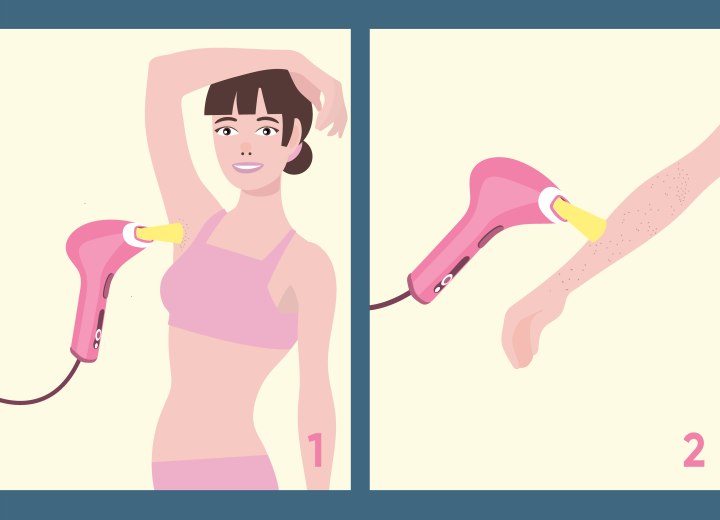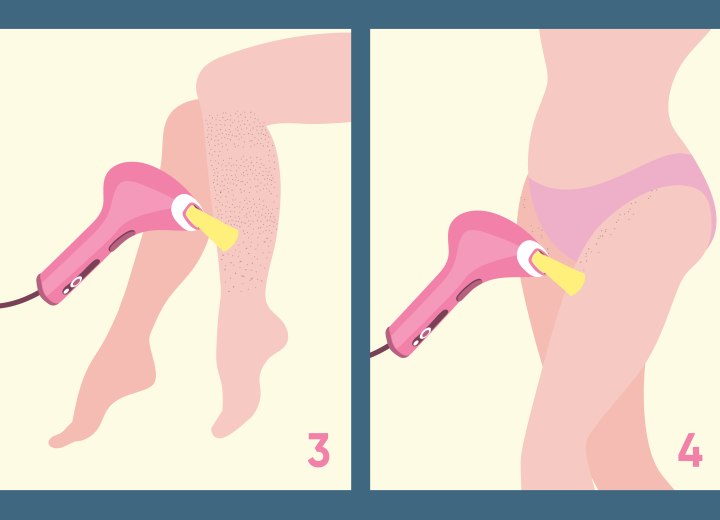Flashlamp Hair Removal

Hair, growing indiscreetly across the body, can cause a great deal of anguish and leave the sufferer searching for ways to remove these unwelcome intruders. Fortunately, because unwanted body hair is such a pervasive problem, affecting literally millions of men and women worldwide, there are numerous hair removal methods available, offering both permanent and temporary solutions to the issue.
One such hair removal solution is called "flashlamps," otherwise known as "Intense Pulsed Light Therapy" (IPL). Unlike the tedious task of shaving the body parts covered in unsightly stubble every few days, flashlamps provide an effective way of permanently removing unwanted body hair.
Similar to laser beams, flashlamps target the pigment of the hair. These handheld devices use high-intensity pulses of full-spectrum, non-coherent light in conjunction with low-range, infrared radiation which is then filtered to produce a specified wavelength light.
When targeted at problem hair, the filtered light flashes onto the skin and causes the hair on the skin to heat up. The mechanical and thermal reactions produced by the heat damage the follicles of the hair. Not only does the hair fall out, but the damage caused by flashlamps or IPL is so intense that it prevents the hair follicles from growing back.
Hair is made up of a pigment called melanin, which has two possible manifestations, eumelanin, which is the dark pigment and is found in dark hair, and phaeomelanin, which is the light pigment found in blonde and red hair. Because the wavelength of light can only be absorbed by the pigment eumelanin, it is only an effective method of hair removal for those with dark brown or black body hair and is consequently ineffective for those plagued by excessive amounts of fair or red body hair.
The History of Flashlamps
Initially flashlights were developed as energy sources for laser beams. Throughout the 1960s and 1970s they were gradually used for medical purposes, particularly for the treatment of skin and eye disorders. Like other hair removal treatments, flashlamps used in this context were a byproduct of other medical applications.
By the mid-1990s, flashlamps were being used to treat vascular lesions, and it was during such treatment that it was noted that hair loss was a side effect. In 1997, flashlamps as a form of hair removal were cleared in the United States by the Food and Drug Administration (FDA). Eleven years later, the method has gradually become more refined and sophisticated and has become an effective and popular way to eradicate unsightly and unwanted hair from the body.

Unlike waxing, shaving, plucking, and hair removal creams, flashlamp hair removal is a permanent hair removal solution. Its ability to eradicate excess body hair permanently has to be flashlamp's primary advantage. If any regrowth does appear, it has been regularly reported that this regrowth is fundamentally finer and lighter than the previous hair.
When flashlamp hair removal is performed correctly by a professional technician, it is an extremely safe method of hair removal. It is also widely testified that IPL is a "virtually painless" hair removal technique and pain relief is not commonly required when undergoing flashlamp treatment.
Another advantage of this method of hair removal is that, unlike other types, such as electrolysis, flashlamps prove to be particularly useful when removing large areas of body hair, for example, from the back or the legs. This is because flashlamps use a large, rectangular beam of light, which can cover larger areas of the body compared to other methods such as laser beams which emit a round and much smaller beam.
The Disadvantages of Flashlamp Hair Removal
Despite the fact that flashlamps have a fairly dynamic history regarding what they were initially used for, there is relatively little information about how much hair loss is typical with IPL. When used in capable hands, flashlamps are a safe way to remove unwanted hair with minimal side effects. Although when the treatment is performed by someone who has inadequate knowledge or experience of the procedure, flashlamps can cause many unpleasant side-effects, such as lesions, burns, discoloration of the skin, and even uneven regrowth.
Although flashlamps are regularly reported as being "virtually painless," they are not completely "painless." The sensation caused by the high intensity pulses of light, while it may not be severe enough to necessitate any pain relief, has been described as a "discomfort." This can be considered a disadvantage compared to other methods of permanent hair removal techniques such as electrolysis, which has often been referred to as "painless."
Similar to laser beam hair removal, flashlamps only target pigmented hair and therefore can only remove body hair that is dark in color. Not being able to assist people with excessive fair or red hair covering their bodies is therefore a major drawback of this type of hair removal technology. Also because the filtered light produces heat which penetrates the skin, it can be partial to discoloring dark-colored skin. Because of this partiality, it is therefore advisable not to be used by people with dark or sun-tanned skin.

Approximately four to seven flashlamp sessions are required to successfully remove hair and impede any regrowth. The price of the treatment depends greatly on the size of the area being treated and varies greatly from clinic to clinic. To eliminate hair from an upper lip with a flash lamp, a consumer could pay up to $100 per session, while a full leg could cost up to $500 per treatment. Compared to many other forms of hair removal, this technique is expensive and is arguably the biggest factor that puts people off undergoing flashlamp treatment.
Recommendations
Due to the potential complications involved with IPL technology, it is highly advisable to do the necessary research and find a reputable clinic that performs this type of hair removal. It is also recommended that waxing be refrained from for four or more weeks prior to the treatment.
Shaving the hairs from the area to be treated is, however, required. Because flashlamps can have a tendency to discolor dark skin, tanning should also be avoided for several weeks and a sunscreen of at least SPF 20 is recommended to be used prior to IPL treatment.
The Flashlamp Hair Removal Procedure
The treatment begins with the application of a thin layer of gel spread onto the skin. Not only does this gel help to protect the skin from any possible damage caused by the intense heat from the lamp, but it also optimizes the transmission of light to the hairs which helps to achieve optimum results.
The lamp is then held in front of the skin for approximately 20 minutes to an hour, depending on the size of the area. The strength of the light used can be altered depending on the density and color of the hair as well as the skin type of the consumer. An after gel is often applied to help cool and soothe more sensitive skin.
Usually the client is expected to return at least four times but more often than not six times until the hair is removed permanently. A gap of six to eight weeks is required between sessions to allow the hair follicles to go through resting and growing phases, as only follicles that are active and in the growing phase can be destroyed by flashlamp therapy.
©Hairfinder.com
See also:
Laser hair removal
Laser hair removal for home use
How to choose a home hair removal system